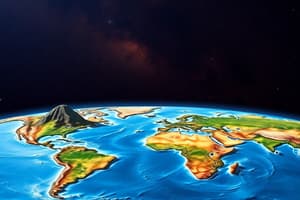Podcast
Questions and Answers
Apa yang menjadi penyebab gempa bumi?
Apa yang menjadi penyebab gempa bumi?
Apa yang terjadi ketika lempeng tektonik berinteraksi?
Apa yang terjadi ketika lempeng tektonik berinteraksi?
Apa yang terjadi pada garis sesar?
Apa yang terjadi pada garis sesar?
Apa yang terjadi pada subduksi?
Apa yang terjadi pada subduksi?
Signup and view all the answers
Apa yang menyebabkan terjadinya gempa bumi fokus dalam?
Apa yang menyebabkan terjadinya gempa bumi fokus dalam?
Signup and view all the answers
Apa yang menjadi penyebab gempa bumi intraplate?
Apa yang menjadi penyebab gempa bumi intraplate?
Signup and view all the answers
Apa yang menjadi salah satu langkah penanggulangan gempa bumi?
Apa yang menjadi salah satu langkah penanggulangan gempa bumi?
Signup and view all the answers
Apa yang dimaksud dengan siklus seismik?
Apa yang dimaksud dengan siklus seismik?
Signup and view all the answers
Bagaimana gempa bumi diukur?
Bagaimana gempa bumi diukur?
Signup and view all the answers
Apa kontribusi aktivitas manusia terhadap gempa bumi?
Apa kontribusi aktivitas manusia terhadap gempa bumi?
Signup and view all the answers
Study Notes
Title: Gempa Bumi SMP Kelas 8: Understanding the Causes of Earthquakes
Introduction
As students of SMP (Madrasah Aliyah) Kelas 8, learning about natural phenomena like earthquakes is an essential part of our education. In this article, we'll explore the causes of earthquakes, which are responsible for the ground shaking and sometimes damaging effects we may have experienced or heard about.
Causes of Earthquakes
Earthquakes are the result of seismic activity deep within the Earth's crust. The following are some of the key factors that contribute to earthquakes:
1. Tectonic Plates The Earth's outer layer, called the lithosphere, is made up of several large plates that float on the asthenosphere. These plates move slowly over time, colliding, pulling apart, or sliding past each other. When the plates interact, stress builds up, creating tension and causing earthquakes.
2. Fault Lines Fault lines are the boundaries where two tectonic plates meet or where a single plate is broken into smaller pieces. The movement of these plates can cause rock layers to slip and move, releasing energy in the form of an earthquake.
3. Subduction Subduction is when one tectonic plate descends into the mantle beneath another. This process can lead to the formation of deep-focus earthquakes, which are located several hundred kilometers beneath the Earth's surface.
4. Intraplate Earthquakes Intraplate earthquakes occur within a single tectonic plate and are not directly caused by plate movement. They happen due to the release of stress built up within the plate itself, usually as a result of the movement of hotspot magma or other geological processes.
5. Man-made Factors While natural processes are the leading cause of earthquakes, human activities can also contribute. For instance, underground mining, the building of large dams, and the extraction of natural gas through hydraulic fracturing (fracking) can all increase the risk of earthquakes in certain areas.
The Seismic Cycle
Earthquakes are part of a natural cycle called the seismic cycle. This cycle consists of three main phases:
1. Accumulation Rock layers within the Earth's crust are gradually deformed and stretched due to the forces exerted by tectonic plates.
2. Release Eventually, the accumulation of stress becomes too great, causing the rock layers to break and slip suddenly, resulting in an earthquake.
3. Recovery After an earthquake, the rock layers return to their original position. However, the stress is not completely released, and the cycle begins again as the rock layers continue to deform and stretch.
Measuring Earthquakes
Earthquakes are measured using a special scale called the Richter scale. The Richter scale measures the amplitude of the seismic waves produced by an earthquake, which is proportional to the energy released. The Richter scale is logarithmic, meaning that each whole number increase represents a tenfold increase in the amplitude of the seismic waves and a corresponding tenfold increase in energy release.
Prevention and Protection
While the causes of earthquakes are largely natural and unpredictable, there are steps we can take to reduce their impact. Some of these measures include:
- Building structures that can withstand earthquakes, such as using reinforced concrete and properly anchoring building foundations.
- Restricting the construction of buildings in areas prone to earthquakes.
- Implementing early warning systems, such as the ShakeAlert system in the United States, which can provide a few seconds of warning before an earthquake strikes.
Conclusion
Understanding the causes of earthquakes is an important part of our education as students of SMP Kelas 8. By learning about the factors that contribute to earthquakes and the measures we can take to reduce their impact, we can gain a deeper appreciation for the natural world and become more informed and responsible citizens.
Studying That Suits You
Use AI to generate personalized quizzes and flashcards to suit your learning preferences.
Description
Explore the causes of earthquakes, including tectonic plates, fault lines, subduction, intraplate earthquakes, and man-made factors. Learn about the seismic cycle, how earthquakes are measured using the Richter scale, and prevention and protection measures. Gain a deeper understanding of the natural phenomena through this comprehensive exploration.



